The short circuit isolator market is forecast to grow from USD 1.1 billion in 2025 to USD 1.5 billion by 2035 with a CAGR of 3.6%. Short-circuit isolators, critical components for protecting electrical systems from damage, are increasingly in demand as industries continue to prioritize electrical safety and reliable power distribution. The market's growth is closely linked to the expansion of industries such as renewable energy, power generation, industrial automation, and construction, all of which require advanced electrical protection systems. As infrastructure development accelerates and new electrical systems are deployed, the need for short circuit isolators will continue to rise.
Technological innovations in smart grid systems and advanced electrical components will further drive the adoption of short circuit isolators. As electrical systems become more complex and interconnected, especially with the rise of distributed power generation (e.g., solar and wind), ensuring their protection is crucial. The increasing focus on electrical safety, particularly in emerging markets where power infrastructure is rapidly expanding, will also support the market’s steady growth over the next decade. Additionally, government regulations aimed at improving safety standards for electrical installations will drive broader adoption of short circuit isolators.
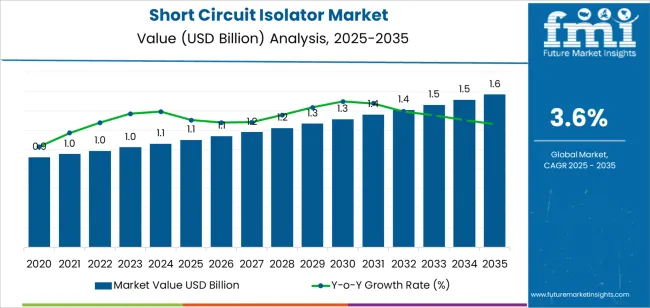
From 2025 to 2030, the market is expected to grow from USD 1.1 billion to USD 1.3 billion, an increase of USD 200 million. This growth will be driven by the growing need for reliable electrical protection across the commercial, industrial, and residential sectors. The demand for smart grids and advanced power distribution systems will also drive market growth, particularly as new energy-efficient technologies are implemented across various industries.
Between 2030 and 2035, the market is forecast to grow from USD 1.3 billion to USD 1.5 billion, adding USD 200 million in value. This phase will be marked by further integration of electrical protection technologies in renewable energy systems, smart cities, and industrial automation. As safety standards and electrical infrastructure continue to improve globally, the demand for short circuit isolators will remain strong, ensuring continued market growth through 2035.
| Metric | Value |
|---|---|
| Market Value (2025) | USD 1.1 billion |
| Market Forecast Value (2035) | USD 1.5 billion |
| Forecast CAGR (2025 to 2035) | 3.6% |
The short circuit isolator market is experiencing steady growth driven by the increasing demand for safety systems across various industries, including fire protection, power systems, and industrial automation. The need for advanced circuit protection technologies that prevent equipment damage caused by short circuits is growing, particularly in sectors where safety and operational reliability are critical.
The rise of smart buildings and intelligent power systems that rely on real-time monitoring and fault isolation is driving the need for short circuit isolators. These isolators are essential in ensuring the protection of electrical systems, thereby reducing operational risks, system downtime, and equipment failure.
The global adoption of smart technologies, particularly in fire protection systems, and power distribution networks is another key factor driving market growth. With the increasing complexity of electrical grids and the widespread use of sensitive electronics in industrial automation and building systems, the demand for short circuit isolators that offer reliable protection is on the rise. Furthermore, regulatory requirements for safety standards and the growing emphasis on fire prevention systems in residential, commercial, and industrial sectors are further contributing to the market’s expansion.
The short circuit isolator market is segmented by type and application. By type, the market consists of electronic type short circuit isolators and resistor type short circuit isolators. The electronic type short circuit isolators segment holds a dominant share, accounting for 55% of the total market. By application, the market is divided into fire protection systems, power systems, industrial automation, and smart buildings, with fire protection systems capturing the largest share of 40%. Countries like China, India, and Germany are key drivers for market growth due to the increasing demand for safety systems, advanced technology adoption, and industrial modernization.
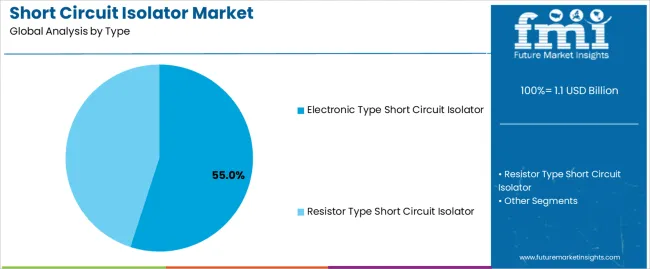
The electronic type short circuit isolator segment dominates the market, capturing 55% of the total share. This segment’s dominance is primarily driven by the advanced protection mechanisms provided by electronic isolators, which offer faster isolation, enhanced safety, and greater operational efficiency compared to resistor-based systems. The integration of electronic isolators into modern systems allows for real-time fault detection, isolation, and recovery, making them ideal for industrial automation, fire protection systems, and smart building applications.
In fire protection systems, electronic isolators ensure that faults are quickly detected, preventing the risk of fire outbreaks from electrical failures. These isolators are crucial for high-speed fault isolation, where every second counts in preventing catastrophic damage. Furthermore, the ability of electronic isolators to support digital monitoring systems and integrate with smart grids enhances their appeal in power systems and industrial automation, where real-time data and intelligent control systems are increasingly necessary. As industries continue to embrace IoT and smart technologies, the demand for electronic isolators will only increase, reinforcing their dominant position in the market.
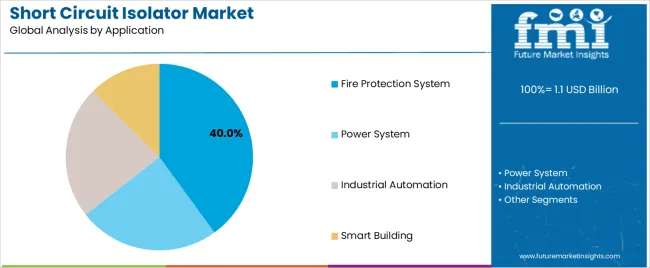
The fire protection system application leads the Short Circuit Isolator market, accounting for 40% of the total market share. This dominance is driven by the critical role short circuit isolators play in preventing electrical fires by isolating faulty circuits in high-voltage electrical systems. As electrical systems become more complex and integrated with smart technologies, the demand for advanced circuit protection systems grows. Fire protection systems rely heavily on isolators to prevent short circuits from escalating into catastrophic failures, especially in high-rise buildings, industrial facilities, and commercial spaces.
The increasing focus on fire safety and regulatory compliance across residential, commercial, and industrial sectors has fueled the demand for short circuit isolators. In these applications, isolators are critical for safeguarding electrical circuits, which can be vulnerable to overload conditions or faulty wiring. The rise of smart buildings with advanced fire detection and monitoring systems is contributing to the expansion of fire protection systems that integrate short circuit isolators for better reliability and quicker response times. Additionally, as urbanization continues, fire prevention systems are becoming more sophisticated, driving the market for short circuit isolators in the fire protection sector.
The short circuit isolator market is driven by the increasing need for safety solutions across various industries, including fire protection, industrial automation, and power distribution systems. The growing adoption of smart building technologies and advanced fire detection systems has fueled demand for short circuit isolators in both residential and commercial applications. Additionally, the rising focus on energy efficiency, electrification, and the need for reliable circuit protection in high-risk environments are contributing to the growth of the market.
What are the key drivers of the short circuit isolator market?
The key drivers of the short circuit isolator market include the increasing focus on electrical safety and fire protection systems across various sectors. As industries and urban areas expand, there is growing demand for reliable protection systems to prevent electrical faults from escalating into larger safety risks, particularly in industrial and residential applications. The rise of smart buildings, industrial automation, and smart grid technologies has also led to a heightened need for short circuit isolators that provide quick fault detection and isolation. Additionally, regulatory requirements and safety standards driving the adoption of advanced circuit protection solutions further contribute to market growth. The increasing adoption of electric vehicles and renewable energy systems also boosts demand for isolators in power systems.
What are the key restraints in the short circuit isolator market?
Despite the growth prospects, the short circuit isolator market faces several restraints. One key challenge is the high cost of advanced electronic isolators, which may limit adoption in price-sensitive industries. Additionally, integration challenges and the need for customized solutions in various applications may increase installation costs and complexity. The limited awareness of the benefits of short circuit isolators in developing regions and smaller markets could also impede market penetration. Furthermore, the demand for isolators is often impacted by the economies of scale; in smaller markets, the need for isolators may not justify large investments, leading to slower adoption rates.
What are the key trends in the short circuit isolator market?
Key trends in the short circuit isolator market include the growing emphasis on smart technologies and automation, which are driving the need for more advanced fault isolation systems. IoT-enabled isolators that provide real-time monitoring and remote diagnostics are becoming increasingly popular, especially in smart buildings and industrial applications. Additionally, there is a trend toward miniaturization and energy efficiency, with manufacturers focusing on compact, high-performance isolators. Sustainability is also gaining traction, with companies increasingly prioritizing eco-friendly solutions that reduce environmental impact. As the demand for advanced fire protection systems and electrical safety solutions grows, these trends are likely to shape the future of the market.
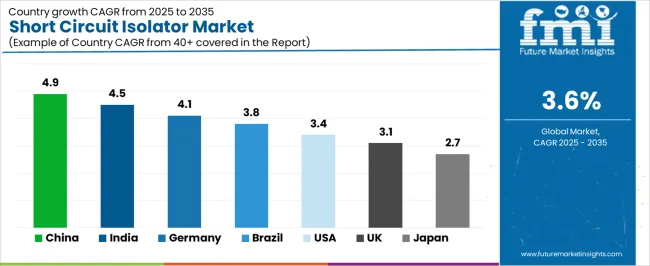
The short circuit isolator market is experiencing diversified growth across key geographies, with higher gains in emerging economies and moderate expansion in mature regions. Countries such as China and India are driving demand because of robust industrialization, infrastructure build out, and heightened safety regulations. In Europe, Germany shows stable growth thanks to its strong manufacturing base and stringent fire/safety standards. Meanwhile, in the Americas and Asia Pacific, countries like the USA, Brazil, the UK, and Japan reflect steady but slower expansion, driven by upgrading of electrical safety systems, smart building initiatives, and modernization of fire protection systems.
| Country | CAGR (2025-2035) |
|---|---|
| China | 4.9% |
| India | 4.5% |
| Germany | 4.1% |
| Brazil | 3.8% |
| USA | 3.4% |
| UK | 3.1% |
| Japan | 2.7% |
China is projected to experience robust growth in the short circuit isolator market, with a CAGR of 4.9%. The country’s demand is driven by its rapid industrialization, infrastructure expansion, and a focus on electrical safety in both industrial automation and commercial buildings. China’s large construction and power grid modernization projects are fueling the demand for reliable circuit protection solutions like short circuit isolators. Additionally, China’s growing adoption of smart building technologies and electric vehicles (EVs) further increases the need for advanced electrical protection to manage high voltage systems and prevent electrical faults. As the nation modernizes its infrastructure and enforces stricter safety regulations, short circuit isolators are essential to prevent electrical fires and protect sensitive equipment, making China a key player in the global market. Furthermore, regulatory frameworks encouraging better fire protection and safety standards in buildings and power systems continue to support market expansion.
India is expected to grow at a CAGR of 4.5% in the short circuit isolator market, driven by expanding infrastructure, industrial automation, and smart building adoption. As one of the fastest-growing economies in Asia, India is increasingly focusing on modernizing its electrical systems to meet new safety regulations and technological advancements. With rapid urbanization and a boom in construction activities, fire protection systems and reliable circuit isolation are becoming critical in urban infrastructure, particularly in high-rise buildings, factories, and power plants. In industrial automation, DC motors, and robotics, the demand for short circuit isolators is rising as industries focus on reducing downtime, improving safety, and ensuring reliable operations. The Indian government’s push for renewable energy solutions, along with an increase in smart city projects, is further accelerating the need for electrical protection solutions. As safety standards and fire prevention systems evolve, India remains a key growth market for short circuit isolators.

Germany is poised to grow at a CAGR of 4.1% in the short circuit isolator market, supported by the country’s strong industrial base, particularly in automotive, power systems, and smart buildings. As a leader in industrial automation, Germany’s demand for advanced electrical protection systems in high voltage equipment, including short circuit isolators, continues to grow. Germany is also home to a large number of manufacturers focusing on energy efficiency and automation technologies, where short circuit isolators are integral to system safety. Additionally, the country’s focus on renewable energy and smart grids is creating demand for protection systems that can isolate faults in power distribution systems. As Germany pushes toward sustainability and the adoption of electric vehicles, short circuit isolators become increasingly essential to ensuring safety in new power management systems and battery infrastructure. The continued focus on fire protection, safety standards, and regulatory compliance will continue to fuel the growth of the market in Germany.
Brazil is forecast to grow at a CAGR of 3.8% in the short circuit isolator market, supported by industrial modernization, expansion of infrastructure, and increasing adoption of safety technologies. As one of the largest economies in South America, Brazil’s demand for short circuit isolators is driven by rapid construction and infrastructure projects, particularly in the energy and automotive sectors. Brazil’s industrial growth and emphasis on renewable energy systems are also fueling demand, as industries upgrade to meet regulatory standards and reduce the risk of electrical failures. In addition, smart building projects and the expansion of fire protection systems in commercial buildings are contributing to the increasing need for reliable electrical isolation. Brazil’s industrial base is becoming more advanced, with increasing adoption of automation technologies, which enhances the market demand for short circuit isolators as part of overall system protection. With the Brazilian government investing in infrastructure, industrial modernization, and safety improvements, the market is expected to grow steadily.
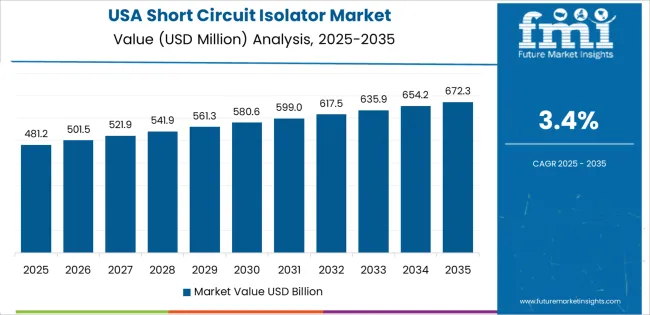
The USA is projected to grow at a CAGR of 3.4% in the short circuit isolator market. As a developed market with mature infrastructure, growth in the USA is more gradual but steady, driven by upgrades to electrical systems in residential, commercial, and industrial applications. The USA continues to focus on modernizing its power grids, with an emphasis on smart grid technology, energy efficiency, and electrical protection. The growing adoption of electric vehicles, battery storage systems, and automated manufacturing systems increases the demand for short circuit isolators to ensure reliable protection in these systems. Furthermore, stringent regulations around fire protection and safety standards are pushing USA industries to invest in high-quality, reliable isolators that ensure the integrity of electrical systems and prevent accidents. While growth is slower than in emerging markets, the USA remains a stable, key player in the global market for short circuit isolators.
The UK is expected to grow at a CAGR of 3.1% in the short circuit isolator market. The UK’s steady demand for fire protection and electrical safety solutions in both commercial buildings and industrial automation is fueling the market. The country’s strong focus on smart buildings, energy efficiency, and green technologies drives the need for advanced short circuit isolators. As part of the UK’s smart city initiatives and sustainability goals, there is a push for innovative electrical protection systems in infrastructure projects. The industrial automation sector, particularly in automotive manufacturing and robotics, continues to grow, increasing demand for isolators that offer reliable circuit protection in high voltage equipment. Although the growth rate is moderate, the UK remains a crucial market in the short circuit isolator space due to its continued emphasis on safety, fire protection, and reliable electrical systems.
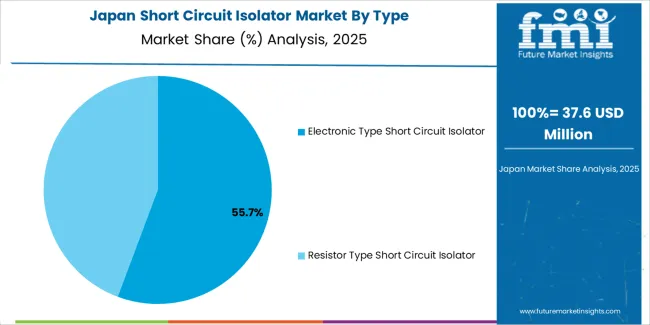
Japan is projected to grow at a CAGR of 2.7% in the short circuit isolator market. Japan’s advanced infrastructure, high tech manufacturing, and focus on safety and reliability in electrical systems continue to support market growth. The country’s adoption of smart factory technologies and robotics in industrial applications requires high performance short circuit isolators to ensure the safety of electrical systems and minimize operational risks. Additionally, Japan’s commitment to energy efficiency and renewable energy solutions is driving the need for advanced protection systems in power grids and electric vehicle charging infrastructure. While Japan's growth is slower compared to emerging markets, it remains a strong market due to the country’s focus on precision engineering and safety standards.

The short circuit isolator market is competitive, with several key players contributing to the growth and innovation of the market. Leading companies such as Honeywell, Siemens, and Bosch dominate with their advanced product offerings and strong industry presence. These players have extensive expertise in electrical safety and fire protection systems, which allows them to offer high-quality, reliable short circuit isolators for various applications. As industries focus on safety standards, regulatory compliance, and smart technologies, these companies continue to innovate in electrical protection solutions and enhance their market position.
Smaller and emerging companies, such as Sanjiang Security, Hochiki, and Fike Corporation, are carving out their market share by offering cost-effective solutions and catering to specific regional demands. These players typically target niche markets such as fire protection, industrial automation, and smart building technologies. As demand for safety solutions continues to rise globally, competition will increase, and the market will likely see more players entering with innovative technologies. Strategic partnerships, mergers, and acquisitions will play a significant role in shaping the competitive dynamics of the market in the coming years.
| Items | Details |
|---|---|
| Quantitative Units | USD Billion |
| Regions Covered | China, India, Germany, Brazil, USA, UK, Japan |
| Type | Electronic Type Short Circuit Isolator, Resistor Type Short Circuit Isolator |
| Application | Fire Protection System, Power System, Industrial Automation, Smart Building |
| Key Companies Profiled | (Please provide companies or I can assist in sourcing them) |
| Additional Attributes | The market analysis includes dollar sales by type and application categories. It also covers regional adoption trends across major markets like China, India, Germany, and the USA. The competitive landscape features key manufacturers in the short circuit isolator sector, focusing on innovations in electronic and resistor-based isolator technologies. Trends in the growing demand for short circuit isolators in fire protection, power systems, and industrial automation are explored, along with advancements in smart building applications. |
The global short circuit isolator market is estimated to be valued at USD 1.1 billion in 2025.
The market size for the short circuit isolator market is projected to reach USD 1.6 billion by 2035.
The short circuit isolator market is expected to grow at a 3.6% CAGR between 2025 and 2035.
The key product types in short circuit isolator market are electronic type short circuit isolator and resistor type short circuit isolator.
In terms of application, fire protection system segment to command 40.0% share in the short circuit isolator market in 2025.






Our Research Products

The "Full Research Suite" delivers actionable market intel, deep dives on markets or technologies, so clients act faster, cut risk, and unlock growth.

The Leaderboard benchmarks and ranks top vendors, classifying them as Established Leaders, Leading Challengers, or Disruptors & Challengers.

Locates where complements amplify value and substitutes erode it, forecasting net impact by horizon

We deliver granular, decision-grade intel: market sizing, 5-year forecasts, pricing, adoption, usage, revenue, and operational KPIs—plus competitor tracking, regulation, and value chains—across 60 countries broadly.

Spot the shifts before they hit your P&L. We track inflection points, adoption curves, pricing moves, and ecosystem plays to show where demand is heading, why it is changing, and what to do next across high-growth markets and disruptive tech

Real-time reads of user behavior. We track shifting priorities, perceptions of today’s and next-gen services, and provider experience, then pace how fast tech moves from trial to adoption, blending buyer, consumer, and channel inputs with social signals (#WhySwitch, #UX).

Partner with our analyst team to build a custom report designed around your business priorities. From analysing market trends to assessing competitors or crafting bespoke datasets, we tailor insights to your needs.
Supplier Intelligence
Discovery & Profiling
Capacity & Footprint
Performance & Risk
Compliance & Governance
Commercial Readiness
Who Supplies Whom
Scorecards & Shortlists
Playbooks & Docs
Category Intelligence
Definition & Scope
Demand & Use Cases
Cost Drivers
Market Structure
Supply Chain Map
Trade & Policy
Operating Norms
Deliverables
Buyer Intelligence
Account Basics
Spend & Scope
Procurement Model
Vendor Requirements
Terms & Policies
Entry Strategy
Pain Points & Triggers
Outputs
Pricing Analysis
Benchmarks
Trends
Should-Cost
Indexation
Landed Cost
Commercial Terms
Deliverables
Brand Analysis
Positioning & Value Prop
Share & Presence
Customer Evidence
Go-to-Market
Digital & Reputation
Compliance & Trust
KPIs & Gaps
Outputs
Full Research Suite comprises of:
Market outlook & trends analysis
Interviews & case studies
Strategic recommendations
Vendor profiles & capabilities analysis
5-year forecasts
8 regions and 60+ country-level data splits
Market segment data splits
12 months of continuous data updates
DELIVERED AS:
PDF EXCEL ONLINE
Short Path Evaporator for Food Market Size and Share Forecast Outlook 2025 to 2035
Shortwave Infrared (SWIR) Market Size and Share Forecast Outlook 2025 to 2035
Short Wave IR LED Market Size and Share Forecast Outlook 2025 to 2035
Short-Term Rental Platform Market Size and Share Forecast Outlook 2025 to 2035
Shortenings Market Size, Growth, and Forecast for 2025 to 2035
Short sleep syndrome Treatment Market Growth & Demand 2025 to 2035
Short-Term Vacation Rental Market Trends – Growth & Forecast 2025 to 2035
Short-Acting Beta-Agonists Market – Trends, Demand & Forecast 2025 to 2035
Short-read Sequencing Market by Product, Workflow, and Region from 2025 to 2035
Short-chain Fructooligosaccharides Market Analysis – Growth, Applications & Outlook 2025-2035
Shortening Powder Market
Ultra Short Base Line (USBL) Positioning Systems Market Size and Share Forecast Outlook 2025 to 2035
Icing Shortening Market Size, Growth, and Forecast for 2025–2035
Frying Shortening Market Size and Share Forecast Outlook 2025 to 2035
Flaked Shortening Market
Specialty Shortenings Market Size and Share Forecast Outlook 2025 to 2035
Vegetable Shortening Market Trends and Forecast 2025 to 2035
Emulsified Shortenings Market Size and Share Forecast Outlook 2025 to 2035
High Ratio Shortening Market Trends – Growth & Applications 2025 to 2035
Dairy Free Shortening Market

Thank you!
You will receive an email from our Business Development Manager. Please be sure to check your SPAM/JUNK folder too.
Chat With
MaRIA